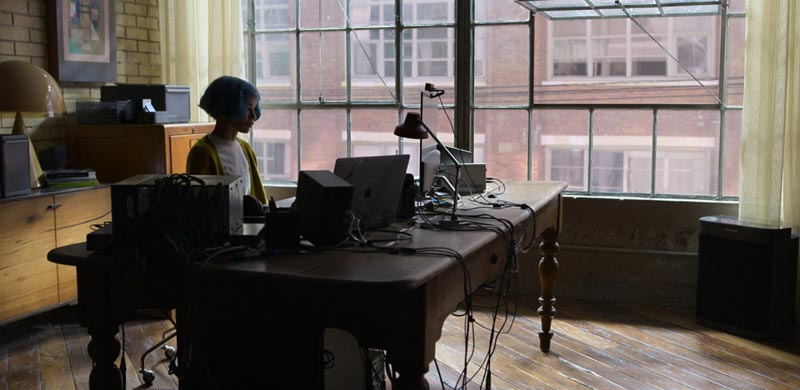2022 Australian Book Design Awards winners
7 June 2022
The winners in the 2022 Australian Book Design Awards (ABDA), which recognise outstanding book cover design, were announced on Friday 3 June 2022.
In Moonland (published by Scribe Publications, August 2021), by Melbourne based Australian author Miles Allinson won the Best Designed Literary Fiction Cover, while Catch Us the Foxes (published by Simon & Schuster, July 2021), by Sydney based Nicola West, took out the award for Best Designed Commercial Fiction Cover.
Cover designs in twenty categories were nominated, and all winners can be seen on the ABDA Instagram page.
RELATED CONTENT
Australian literature, awards, design, Miles Allinson, Nicola West
Kimi, a Rear Window inspired thriller by Steven Soderbergh
7 June 2022

Still from Kimi, courtesy of Warner Brothers.
Angela (Zoe Kravitz) is a housebound voice stream interpreter who spends her days correcting errors a virtual assistant named Kimi makes. Typically Angela is required to familiarise Kimi with slang terms and clarify user instructions the virtual assistant doesn’t understand.
But when Angela hears what sounds like a violent assault on a recording that’s been flagged for review, she urges her managers to inform the authorities. But the would-be crime is an inconvenience CEO Bradley Hasling (Derek DelGaudio) has no time for.
The company is about to float on the sharemarket, and Hasling is more focussed on the payout due to him. He wants Angela to drop the matter, insisting the recording is some sort of glitch. When Angela refuses to relent, she finds herself pursued by people who will stop at nothing to protect their interests.
Kimi, trailer, directed by American filmmaker Steven Soderbergh, is choke full of references to Alfred Hitchcock’s 1954 classic Rear Window. Soderbergh still delivers us the neighbours peering into each other’s windows, but adds COVID, face masks, and smartphones to the mix. The storyline may be on the straightforward side, but the brisk runtime means there’s seldom a dull moment.
RELATED CONTENT
Derek DelGaudio, film, Steven Soderbergh, Zoe Kravitz
Remaining mindful of Australian Indigenous reconciliation
7 June 2022
National Reconciliation Week, a celebration of Australian Indigenous history and culture, concluded last Friday, 3 June 2022. But there are still ways we can remain mindful of reconciliation, and the history and culture of Indigenous Australians, daily, and immersing ourselves in First Nations art, film, and literature, are some of the ways we can achieve this.
RELATED CONTENT
A trailer for Juniper, a film by Matthew J. Saville
7 June 2022

Still from Juniper, courtesy of Transmission Films.
Juniper, trailer, is the debut feature of South African born New Zealand filmmaker Matthew J. Saville. Set in rural New Zealand, the story brings together two headstrong characters, Ruth (Charlotte Rampling), an alcoholic, and Sam (George Ferrier), her troubled grandson, who find themselves forced into each other’s company.
Sam (17) has been on a self-destructive spiral that could lead to his death. He returns home from boarding school to find his wheelchair-bound English grandmother, Ruth has moved in. Ruth is an ex-war photographer with a lust for life and a love of the bottle. Sam soon finds himself profoundly confronted by her alcoholic wit and chutzpah. Their first meeting is awkward; their second violent. Things get worse when Sam finds himself stranded alone with her and her nurse Sarah for the school holidays. Both strong-willed characters, a battle of supremacy ensues, enabling Sam to embrace life again and for Ruth to face her mortality.
RELATED CONTENT
Charlotte Rampling, film, George Ferrier, Matthew J. Saville, trailer
PRIDE on SCREEN, LGBTIQ+ films, Cinema Nova, Melbourne, June 2022
6 June 2022
PRIDE on SCREEN is a celebration of Pride Month, taking place at Melbourne’s Cinema Nova, from Friday 10 June 2022, until Wednesday 15 June.
Cinema Nova celebrates Pride Month with a curated selection of premiere screenings, new releases and big-screen classics exploring stories from across the LGBTIQ+ experience, screening from Friday June 10.
After Blue, trailer, a science-fiction feature made by French director Bertrand Mandico in 2021, is one of the films showing at the festival. Set on a planet where only women can survive, After Blue tells the story of a hairdresser and her daughter, as they hunt for a notorious killer, named — curiously — Kate Bush.
RELATED CONTENT
Bertrand Mandico, events, film, trailer
Winnie Dunn, Michael Mohammed Ahmad, speak with Roanna Gonsalves
6 June 2022
Roanna Gonsalves, creative writing lecturer and author, speaks to Winnie Dunn and Dr Michael Mohammed Ahmad, at Waverley Library, in Bondi Junction, Sydney, on Saturday 11 June, from 11AM until 12PM.
Dunn is the general manager of the Sweatshop Literacy Movement, while Ahmad’s third novel The Other Half of You, was published last year. The speaking event is part of an initiative by Waverley municipal council to curb racism in the community.
RELATED CONTENT
Australian literature, events, Michael Mohammed Ahmad, Roanna Gonsalves, Winnie Dunn
Zelensky, a book by Andrew L Urban, Chris McLeod
6 June 2022

Zelensky (published by Wilkinson Publishing, April 2022), is a portrait of Volodymyr Zelensky, the president of Ukraine, written by Australian author and former film critic Andrew L. Urban, and journalist and author Chris McLeod, which examines Zelensky’s resilience in the face of the Russian invasion of his country.
No one has been more surprised by Zelensky’s power to inspire and mobilise his countrymen and the world than Vladimir Putin, who expected Russia’s conquest of its beleaguered neighbour to be the work of an afternoon. Outfoxed and isolated, Putin is not the first person to have underestimated the former comedian with a spine of steel.
RELATED CONTENT
Andrew L. Urban, Australian literature, Chris McLeod, non-fiction, Ukraine
Chloe, a TV series by Alice Seabright
4 June 2022
Chloe, trailer, is a TV series for our stalk-book, socials, obsessed times, from British writer and director Alice Seabright. Twenty-something Becky (Erin Doherty), lives at home with her mother. When not working as a temp, she closely follows the lives of glamorous and beautiful, and develops a fascination in particular with the life of a young woman named Chloe. When tragedy strikes though, Becky feels the needs to learn more about the woman she has become infatuated with.
When Chloe dies suddenly, Becky’s need to find out how and why leads her to assume a new identity and engineer a “chance” meeting with Chloe’s best friend, Livia (Bennett-Warner), and infiltrate Chloe’s group of close-knit friends. Through her alter-ego Sasha, Becky becomes a powerful, transgressive heroine; a popular, well-connected “someone” with a life, and loves, that are far more exciting and addictive than the “no one” she is as Becky. However, the pretence soon obscures and conflates reality, and Becky risks losing herself completely in the game she is playing.
Chloe debuts on Friday 24 June 2022, but you can follow — if you’re game — Chloe’s Instagram page in the meantime.
RELATED CONTENT
Alice Seabright, Erin Doherty, television, trailer
Is an Australian republic any closer than it was 25 years ago?
4 June 2022
Australian federal MP Matt Thistlethwaite has been appointed to the role of assistant minister for the republic, in the new Labor led government, a move that will put the question of an Australian republic, and an Australian as head of state, rather than the British monarch, back on the agenda.
The push for Australia to break away from the monarchy has received its best news in 25 years after Prime Minister Anthony Albanese appointed an assistant minister for the republic. Australian Republic Movement chair Peter FitzSimons says the appointment of Matt Thistlethwaite was a major show of support. It remains to be seen what progress Labor will make on the issue after it confirmed a constitutionally-enshrined First Nations Voice to Parliament was its referendum priority.
A break from the British monarchy has long been on the cards. In 1995, then Prime Minister Paul Keating declared Australia should become a republic. But the notion was was rejected by the Australian people in a 1999 referendum, with about fifty-five-percent of the population voting against the proposal. But twenty-three years on, support for a republic could hardly be called overwhelming.
Polling conducted earlier this year in the states of New South Wales, Victoria, and Queensland found a little over a third of people supported an Australian republic, while a little under a third were opposed. But closer to forty-percent — a significant margin — said they were “unsure or neutral” on the matter. When posed the question: yes or no, would you support a republic, fifty-four-percent of respondents said yes. But it’s not much of a margin, and I’d contend a minimum of sixty-percent of Australians would need to be firmly in favour for the idea to carry.
But Australians appear to have other priorities, and the matter of a republic is of little interest to many, although that doesn’t mean Australia is a country filled with monarchists:
The biggest hurdle for republicans is the reality that Australia is already an independent nation, with only sentiment and inertia linking us to the British crown. Most Australians, when pressed, struggle to remember the name of the current governor-general or to explain their role.
Interestingly, this week marks the British monarch, Queen Elizabeth’s, seventieth jubilee. I only know because I try to keep up with the news. A month ago I’d have had no idea the occasion was imminent. Certainly I’m not aware of any events locally to acknowledge the milestone. I see no banners flying on the streets, nor detect any sort of buzz of interest generally. People seem to be going their day-to-day affairs as normal.
But another obstacle for those in favour of a republic is what the exact role of any head of state, presumably a president, would be. What sort of executive power would they be invested with, and how would they assume office? Should they be appointed by the Australian parliament, or elected by popular vote? There are many questions to address.
Personally I think Australia should be a republic, and a nation with a head of state chosen by the people. It may only be a symbolic gesture, but it’s an important one.
RELATED CONTENT
Triple J losing radio listeners en masse says new radio survey
2 June 2022
Radio listeners have been abandoning the Australian Broadcasting Corporation in droves, according to the latest rating survey conducted by GfK. Youth radio station Triple J — incidentally about the only station I listen to, if I listen to radio at all — in particular has seen a tumble in popularity, with listeners aged 18 to 24 especially, tuning in elsewhere:
In the last survey, Triple J dipped 4.6 percentage points in the 18-24 demo, from 20 per cent to 15.4 per cent, but has seen that number almost half in this survey, dropping 7.4 percentage points for an 8.0 per cent share. This places Triple J behind Smooth FM (8.5 per cent, up 2 percentage points) and WSFM (8.3 per cent, up 2.9 percentage points) among younger listeners.
That’s an alarming set of numbers. While recent government funding cuts to the ABC have undoubtedly contributed to the fall off, I’m wondering what else might be at play.
For further reading on ABC audience numbers, Tim Burrows, formerly of Mumbrella, offers some deeper analysis of the latest radio survey findings.
RELATED CONTENT
